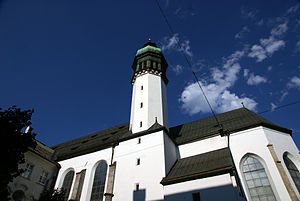Hofkirche, Innsbruck
| Hofkirche | |
|---|---|

Hofkirche in Innsbruck, Austria
|
|
| Basic information | |
| Location | Innsbruck, Austria |
| Geographic coordinates | 47°16′06″N 11°23′43″E / 47.26839°N 11.39525°ECoordinates: 47°16′06″N 11°23′43″E / 47.26839°N 11.39525°E |
| Affiliation | Roman Catholic Church |
| State | Tyrol |
| Year consecrated | 1553 |
| Status | Active |
| Architectural description | |
| Architect(s) | Andrea Crivelli |
| Architectural style | Gothic, Renaissance |
| Founder | Emperor Ferdinand I |
| General contractor | Nikolaus Turing |
| Groundbreaking | 1549 |
| Completed | 1553 |
| Direction of façade | NNE |
The Hofkirche (Court Church) is a Gothic church located in the Altstadt (Old Town) section of Innsbruck, Austria. The church was built in 1553 by Emperor Ferdinand I (1503–1564) as a memorial to his grandfather Emperor Maximilian I (1459–1519), whose cenotaph within boasts a remarkable collection of German Renaissance sculpture. The church also contains the tomb of Andreas Hofer, Tyrol's national hero.
Although Maximilian's will had directed that he be buried in the castle chapel in Wiener Neustadt, it proved impractical to construct there the large memorial whose plans he had supervised in detail, and Ferdinand I as executor planned construction of a new church and monastery in Innsbruck for a suitable memorial. In the end, however, Maximilian's simple tomb remained in Wiener Neustadt and the Hofkirche serves as a cenotaph.
The Hofkirche is located at Universitätsstraße 2, adjacent to the Hofburg in the Altstadt section of Innsbruck. The church was designed by architect Andrea Crivelli of Trento in the traditional German form of a hall church, consisting of three naves with a setback three-sided choir, round and pointed arch windows, and a steep broken hip roof. Its layered buttresses reflect compromise of contemporary Renaissance design with German late Gothic style. Stonemasons Hieronymus de Longhi and Anton de Bol carved the fine Renaissance portal.
The church interior contains galleries, high slender colonnettes of red marble with white stylized Corinthian capitals, and a lectern. The gallery's original ribs made from sandstone from Mittenwald have been preserved, but after the main vault was damaged by earthquake in the 17th century, it was rebuilt in the Baroque style.
...
Wikipedia
